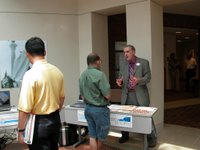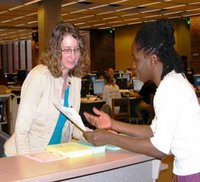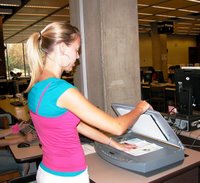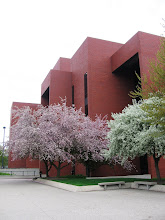Fall Semester classes began at Ball State on Monday, August 21. On the day before, freshmen assembled in groups to discuss this year’s Freshman Common Reader,
First They Killed My Father by Loung Ung.
Group leaders were volunteers drawn from faculty and staff, including six librarians and one paraprofessional from the University Libraries.
The whole idea behind the Freshman Common Reader is for new students to have a common topic as a group for discussion. Reading and discussing a book also serves as a focal point for subsequent campus activities. Later this fall semester, for example, programs will feature a campus visit by the book’s author, a stage production of Twilight, and a screening of the 1984 film
The Killing Fields.
Students who participate in some or all of these activities have the opportunity early on to gain an awareness of the richness available as members of the Ball State academic community.
This year’s common reader is a harrowing tale of survival. It recounts the flight of Loung Ung’s family’s from their home in Cambodia’s capital Phnom Penh during the city’s evacuation in April 1975. It provides insight into life under Pol Pot’s Khmer Rouge and describes how disease and murder ultimately claimed the lives of Ung’s parents and two sisters. The author also tells about her eventual escape to the United States shortly after the fall of the Khmer Rouge in 1979 at the hands of Vietnamese occupying forces.
One of the values of reading this work is to expose students to past and current world events, to challenge preconceptions and viewpoints, and to open students’ thinking for greater diversity of thought – in the context of respecting students’ belief systems.
Eric Fisher – Information Services Evening Librarian
The common reader discussion groups are very much like book clubs that meet in many libraries ... By the end of the session, we were talking about immigration issues and question of how we decide political asylum for refugees to the U.S.
Amy Trendler – Architecture Librarian
I had a good discussion about the book with my group ... I was impressed with the students’ participation. I think reading a common book was a good way for students to begin their academic careers and to develop a sense of community.
Kathleen Pickens – Access Services Evening Supervisor
I was really excited to lead a Freshman Connections group discussion, particularly because the author’s experiences as related in the book generate so many diverse themes. Mingled with my excitement was a degree of apprehension about whether or not the students would share my enthusiasm ... By the end of our time together, the students were voicing their opinions that the ultimate reason human beings need choices and the freedom of expression.
Jim Hammons – Head of Library Enterprise Services and Systems
I have lead discussion groups twice before. This year's group was the most involved. The students’ sentiment was that the book was "too depressing to read during the summer," but they still felt compelled to read it and cared enough to discuss it seriously. This book was shortlisted the two years I was on the book selection committee, and I’m glad it finally made it.
Keith Cochran – Music Librarian
Our group discussed how individuals and society suffer under totalitarian rule. We talked about how the Khmer Rouge affected the author’s life and Cambodian society. I read several passages from the book that dealt with these issues.
Alida Pask – Information Services Librarian
Despite a crowded room, the 38 students were eager to share their thoughts and opinions. Several students expressed interest in attending the upcoming Loung Ung public lecture, and they are ready with questions to ask about her life and the beliefs she holds now. By participating in the freshman common reader program, I was able to meet a few new students and promote the University Libraries’ programs, services, and collections.
For more information about The Freshman Connections program, view the website at
www.bsu.edu/freshmanconnections








